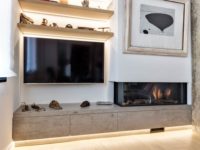Regional stone played a vital role in the design of a 4,500-square-foot residence in Pittsburgh, PA, built by Avanti Construction of Pittsburgh. Homewood sandstone, in the Bloom Run® color range, supplied by Russell Stone Products, extensively dresses the home’s exterior and interior design.
“We wanted a beautiful stone that would last forever,” stated the team at Cullen & Associates of Pittsburgh, the architects for the project. “Russell’s kiln dried process was a selling point.”
Russell Stone Products supplied approximately 260 tons of the sandstone, which has been classified as a “Class II Quarzitic Sandstone.” Moreover, the stone producer recently completed a two-year study with the Natural Stone Institute (NSI) and is now classified as a “Type III EPD stone.”
“EPD (Environmental Product Declaration) makes our stone a desirable product to be used for LEED, The Green Globes System, BREEAM New Construction and CHPS Buildings,” said Dave Curulla of Russell Stone Products. “It lowers the embodied carbon footprint in the construction process. Stone from cradle to grave dominates the results in all product categories for environmental indicators. Our stone’s durability allows it to perform impeccably in commercial and residential applications for interior and exterior use. Stone rarely reaches an end of its performance in its service life.”
The sandstone used on the residence was a combination of stone panels and sawn bed building stone, sawn on four sides with hand rock faced fronts. On average, pieces measured 12 x 24 inches at the base and the stone used on the upper portion of the residence were rectangles and squares.
The sandstone creates an elegant exterior facade. It was also used for steps and treads, which were honed or sandblasted for slip resistance. Additionally, the sandstone can be found as wall caps, window trim and countertops. All emblems, medallions and the entrance were created with CNC machines.
Russell Stone Products provided mock-ups for the design team to review prior to installation. “It was helpful to see the stone color variation to help explain the natural products’ realities,” stated the team at Cullen & Associates.
One of the most challenging aspects of the project was fitting the project on a very tight piece of property. “The homeowners really loved the location, so we had to squeeze the footprint onto the lot,” stated the design team. “There was no leeway at the sides or front. It was very tight.”
The masons at Jubic Masonry in Finleyville, PA, agreed with the architects. “Since the building lot was not big enough to drive our all-train forklift around the whole house, it certainly was challenging because of the weight of some of the bigger stones,” they said. “[Also], the fact that the house and garage were built right on the 5-foot setback limits on both the house and garage was also a challenge. But, the architect was great to work with on this project and the homeowners were also wonderful.”

